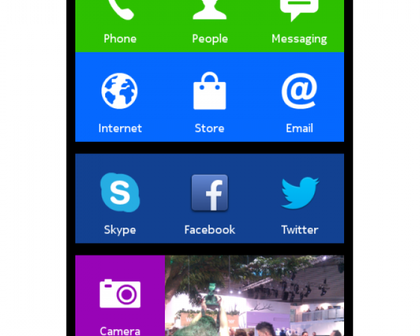Nokia X review

We take a look at Nokia's Android-based super-budget smartphones
Nokia has caused quite a stir at MWC this year by launching its first Android phones. These are desiged to slot in below the Lumia range, and are very cheap for smartphones, starting at just €89 (£73 approx).
Nokia X interface
The X range consists of three handsets; the X, X+ and XL, and all three run Nokia’s custom version of Android – so custom, in fact, that there’s no Google Play store at all. Instead, you get a Windows Phone-like interface with big primary-coloured tiles, and you get your apps from the Nokia Store. We had a look in the Nokia Store for common apps such as RightMove, National Rail and BBC iPlayer, all of which are available for Windows Phone and Android, but couldn’t find any of our favourites.

Like Windows Phone… but not
The X does support third-party app stores such as Yandex, SlideME, Aptoide and 1Mobile Market, but we couldn’t find our favourite apps in those stores either. We’re not convinced that, just as Windows Phone’s app store is beginning to reach critical mass, we’d like to ditch it and plump for a platform with fewer useful apps than either Windows Phone or Android. It’s too early to write it off, of course, and it remains to be seen how many developers are willing to tweak their apps for the X platform.
The OS itself, which the phone reports as Nokia X rather than Android, is reasonable-looking and easy to use. Your apps exist all on one scrolling screen rather than in a separate Start menu for your favourites and a main app tray for the rest. This means you may find individual apps tricky to find if you install too many, but it keeps the interface simple.
Unfortunately, while even the very cheapest Windows Phone handsets run smoothly, the same can’t be said for the X handsets we tried. Each one showed some jerkiness when panning about the app tray – something we’re used to seeing on Android phones, but not on on Windows Phone handsets.
Nokia X hands on
The Nokia X is the cheapest of the handsets, at just €89. For this you get a dual-core Qualcomm MSM8625 processor, a 4in 800×480 IPS display and 512MB RAM. The phone also has a 3-megapixel rear camera – by far its most budget aspect.

As we were expecting from Nokia, the phone feels much classier to hold than most phones this cheap. We particularly liked the X’s soft-touch rear. The screen showed bright whites and accurate colours, too.
Performance-wise, the X was the slowest of the range. The home screen in particular felt jerky while we were scrolling around. The X also has a slow web browser. In the Sunspider JavaScript benchmark, the phone only managed a score of 2,548ms, which is slow by current standards. Even the mobile version of the BBC News website was jerky as we scrolled up and down .
An important point to note about the X is that it has just 4GB storage, and unlike the X+, no microSD card slot.
Nokia X+ hands on
The €99 (£82 approx) X+ is similar to the X, and also has a 4in display with an 800×480 resolution. Your extra €10 gets you an added 256MB RAM, taking the total up to 768MB, and the all-important microSD card slot for storage expansion.

Surprisingly, the extra RAM made itself felt when we were using the handset, as the main interface was much smoother. However, web browsing performance was not improved, and even mobile versions of websites were jerky. A slow 2,589ms in the Sunspider JavaScript benchmark reinforces the phone’s slow web performance.
Your extra handful of Euros doesn’t get you an uprated camera, unfortunately – for more than a lowly three megapixels you’ll have to stretch to the Nokia XL.
Nokia XL hands on
Coming in at €109 (around £90), the XL is astonishingly cheap for a phone with a 5in IPS display. You still only get an 800×480 resolution, though, and the larger screen means text has a slightly blurry quality. It also has a five-megapixel camera, which is more acceptable in 2014 than the X and X+’s 3-megapixel models.

Like the Nokia X+, the XL has a microSD card slot for expandable storage and 768MB RAM, so while the web browser is still slow, the main menus are smoother than on the bottom-of-the-range X. The phone feels great in the hand, thanks to its soft-touch rear, and, like the rest of the range, comes in a variety of shockingly vibrant colours.
The X range will start shipping in March, but Western European countries won’t see the phone until later. The lack of popular apps is definitely a problem, and for the moment we’d much rather spend £120 on a Lumia 520, but the app situation may improve and there’s no denying how much phone the X range gives you for your money. Watch out for our full review soon.
